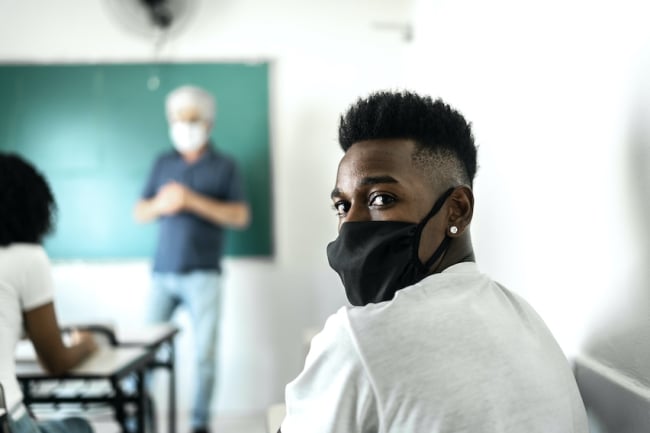You have /5 articles left.
Sign up for a free account or log in.

As mask mandates drop, some fear that the most vulnerable will be stigmatized for protecting themselves.
FG Trade/iStock/Getty Images Plus
As higher education slowly returns to a long-awaited sense of normalcy, college students and employees with disabilities worry that they’ll be forgotten in the rush to dial down coronavirus mitigation factors, noting that COVID-19 continues to pose a lethal threat to high-risk individuals.
Case rates vary significantly at the state, county and city levels. Some colleges have recently dropped mask and vaccine mandates, even as others restore such practices or shift classes online amid local surges. But regardless of the numbers, some advocates for students and employees want to see universal standards in place to protect those most at risk.
Some advocates say students are being asked to choose between their education and their lives.
“Universities aren’t necessarily listening to disabled students,” said Eiryn Griest Schwartzman, who co-founded COVID Safe Campus, an advocacy organization for students and employees with disabilities. “That push to return to normal has persisted. It gets demoralizing, and it gets harder to continue to advocate. And it could potentially result in people stopping their education if they feel like they don’t have the resources to keep going and feel undersupported.”
Grading College Responses
COVID Safe Campus, a group of high-risk academics and activists with disabilities, recently launched a report card grading college coronavirus policies. The effort, they say, grew out of concerns that high-risk individuals are being left behind as colleges return to pre-pandemic normalcy.
With May 1, National Decision Day, on the horizon, Griest Schwartzman said the report card aims to bring awareness to campus policies as prospective students choose a university. Griest Schwartzman—who uses they/them pronouns—hopes that students will use the tool to help find a college where they feel safe. But they also hope it pushes colleges to improve their policies.
“Some of the schools that have higher grades have shown that they are more committed to public health, and they are ready to lead other schools,” Griest Schwartzman said. “Students really need the assurance that [safety measures] are going to continue and they have predictability, because the lack of predictability with all the changes in policies can be really disruptive to our education, work experiences.”
Griest Schwartzman acknowledges that policies will inevitably change by the fall, when students enroll, but that the report card will change with it. The first version was released earlier this month, and it will continue to be updated. They suggest that colleges with strong scores are leading the way on best practices, which signals a commitment to long-term support for those at risk.
The report card, as it stands, currently grades only 90 institutions. Colleges are graded on masking, COVID-19 testing and vaccination policies, as well as on access to remote and hybrid learning opportunities. The underlying data that make up these grades come from details submitted by students, faculty and staff at the colleges themselves.
Of the 90 institutions on the list, most received a D or an F grade; none earned an A.
Colleges on the list don’t have much to say about the report card—at least not on the record. Of nearly a dozen colleges contacted, none provided a statement about the report card. Some, however, questioned the reliability of the data, the methodology and whether it was even newsworthy.
Only the University of Washington, which received an F, offered a statement emphasizing that it followed appropriate guidance in setting policies.
“The University of Washington has based every decision we have made regarding remote instruction, masking, vaccination and testing on scientific evidence and guidance from our own experts and federal and local public health agencies,” spokesperson Victor Balta wrote in an emailed statement. “We have largely avoided broad transmission in our learning, working and living spaces, we have provided free testing to our community, required vaccinations and adjusted mask guidance as supported by scientific evidence. Providing a safe, healthy and secure learning environment is paramount and, while we understand these are difficult and sensitive issues, we believe we have done what is best for our students, faculty and staff.”
The small team behind the report card believes that’s not enough. They worry that lives will be lost without continuing measures to stop the spread of coronavirus. Advocates at COVID Safe Campus want masking and vaccine policies to remain, investments to improve air quality, dedicated housing for those in high-risk categories, and ongoing remote learning access.
“We should permanently have more precautions on campus,” Griest Schwartzman said. “The flu is always here—we should wear masks as a courtesy for that. We should always include more public health measures on campus and more health communications to keep our communities healthy, especially when a lot of schools I know really want to invest in student health and the health of their entire campus community. And a way to do that is to continue some of the policies that we’ve seen taken away recently that we know are really effective, that we know can help include more people, and keep people in education, and help people graduate.”
Best Practices for High-Risk Communities
While the advocates at COVID Safe Campus are sharply critical of colleges’ efforts to dial back mitigation measures, others suggest that institutions largely have done a good job of handling the pandemic, even for those who face the greatest threat from the coronavirus.
“During COVID, they have risen to the challenge and provided more services, more hours and focused especially on students with high-risk conditions, those students who are disadvantaged in some way, that have a greater risk for exposure or risk of serious disease from COVID,” said Gerri Taylor, co-chair of the American College Health Association’s COVID-19 task force.
But Taylor acknowledges colleges can do more, including by battling the stigma of wearing face coverings as mask mandates drop across the U.S.
“I think we have to continue to be concerned about these individuals; I do think that each person has to take responsibility for themselves as well,” Taylor said. “And if they need to wear a mask, then they should not be discriminated against in any way. Colleges and workplaces should have campaigns to decrease any stigma for people who need to wear masks or need to do some of their work from home, or need to be socially distanced. I think we’re going to find that and more of an acceptance and nonjudgmental attitude towards people who have those needs.”
Ultimately, responses to COVID-19 have been as varied as the colleges themselves.
Jamie Axelrod, director of disability resources at Northern Arizona University and past president of the Association on Higher Education and Disability, notes that there are a variety of factors to consider, such as state and local ordinances, that shape institutional responses to COVID-19.
Then, of course, there’s the matter of money.
“A small private liberal arts college may have a very different set of resources, ways in which they deliver academic curriculum, as compared to a large public land-grant institution. But we have learned through the pandemic that there may be more varieties of ways to effectively deliver education than we thought before or that people were willing to try. For particular student situations, we may need to investigate what would be reasonable and appropriate and feasible,” Axelrod said.
With every student and employee navigating a different set of circumstances—some with visible disabilities, others with invisible impairments—it’s important to individualize the services provided, he said.
“I think that flexibility is going to be key, and the more flexibility we can build in from the beginning, the more people’s circumstances that will hopefully address,” Axelrod said. “But we still may need to then hold open that possibility for individualization when it is reasonable and appropriate to do given the programs or the services. Of course, the other thing we can do is recognize that as we come back together, different people are going to make different personal choices about being in social circumstances, and treating people’s choices about that in a respectful way.”
While colleges can make certain investments in airflow, COVID-19 testing and providing access to vaccines, following the data on case rates is also extremely important, experts say. Though current mitigation measures may be imperfect, colleges now have two years of experience to draw on to shape policy and be proactive and reactive to better serve their communities.
“If the college is looking at air quality, looking at the data, flexing their mitigation strategies based on the metrics that they’re seeing change in their communities, I think we can make the situation safer for all members of our community, including those with high-risk conditions,” Taylor said. “You also want to continue to encourage, as strongly as possible, vaccines and boosters. We know that those work, those are tried and true and have very few side effects, if any.”




